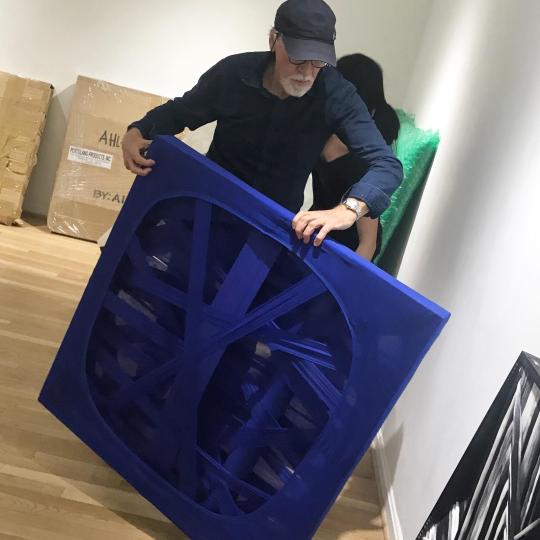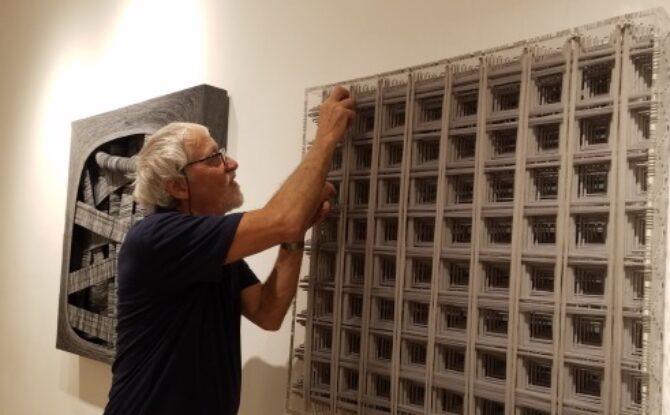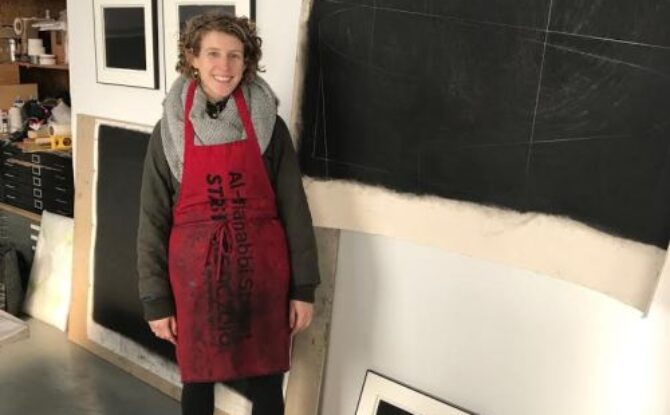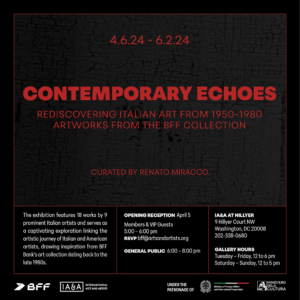English | Italiano
A renowned fashion designer, Emilio Cavallini is known the all over the world for his innovations in stockings and hosiery. In a career spanning three decades, Cavallini has collaborated with design houses ranging from Mary Quant to Dior, Balenciaga, Alexander McQueen, and more. Beginning in 2010, he gave up designing for women’s legs in order to devote himself entirely to designing on canvas and creating fine art, but not too much has changed—we can still find his unique artistic expression, dedication and elegance in his practice.
Cavallini’s fine art was first displayed to the public in early 2011 for a solo exhibition at the Triennale Expo in Milan. Emilio Cavallini’s masterpieces draw the spectator’s gaze into a new mystical world, seemingly comprised only of stockings. This trascendental effect is achieved by the perfect union between nylon thread, emptiness, mathematics and genius. In his hands, new mathematical discoveries, through complex processes, are developed into works of art.
In partnership with the Embassy of Italy and the Italian Cultural Institute, IA&A at Hillyer is currently exhibiting a retrospective of Cavallini’s works, including Fractals, Diagrams, Bifurcations and Actual-Infinity. Concurrently, the Italian Cultural Institute is exhibiting three stunning masterpieces inspired by the Italian Mannerist painter of the 13th century, Giacomo da Pontormo, creating an original union between old painting and new mathematical discoveries of our century.
Objectual Abstractions is on view at IA&A at Hillyer and at the Italian Cultural Institute (appointment only) from May 4-27, 2018.
What makes nylon thread and stockings your medium of choice? Do you find there are mathematical principles inherent to the production of hosiery?
It was in designing and producing my first stockings that I identified the tools with which I have built my dream of creating art. The mathematical principles were applied after I designed and produced samples of stockings.
Do you draw your ideas before executing them? Can you tell us a little bit about how you go from concept to finished product?
The socks are designed so that they can be made by machines following my instincts for making fashion. All of my designs are also based on my knowledge about the world of art both ancient and modern.
What are your major inspirations? In conjunction with the exhibit at Hillyer, the Italian Cultural Institute is also showing some of your artworks inspired by Jacopo da Pontormo’s paintings. What drew you to these Mannerist works?
My inspiration comes from the street, commercials, movies, television, and from my fondness for art of the Greek Classical period and the Renaissance. Colors are important, and from the Renaissance I have drawn great inspiration from Pontormo, Rosso Fiorentino, Michelangelo, Raffaello, etc. Thus my colorful fractals were born, drawing on shades prevalent in those works.
You spend your time in Milan and New York. What has it been like to show your work in LA and now in Washington, DC?
Living in Italy, where art is very invasive and makes you lose your sense of what is modern, it was by hanging out in New York in the 60s that I gained strength and courage to undertake not only making fashion but also the creation of works of art. My passion for mathematics made my artistic work easier and more unique. Exhibiting my work not only in Italy but also in New York and Los Angeles and now Washington [DC] has been a great pleasure because I have been able to show my work to many more people.
What concepts are you exploring in your new work?
I am juxtaposing the mathematical concepts of my works with those of light and the colors of the rainbow of which it is composed.
OBJECTUAL ABSTRACTIONS: INTERVISTA CON EMILIO CAVALLINI

Emilio Cavallini è oggi conosciuto in tutto il mondo prevalentemente in quanto stilista di moda di fama internazionale. Con una carriera che si estende per tre decenni, Cavallini ha collaborato con differenti case di moda, da Mary Quant a Dior, Balenciaga, Alexander McQueen e altre. Smise di vestire le gambe delle donne a partire dal 2010 per dedicarsi completamente al vestire tele, ma poco cambia; continuiamo a trovare la stessa arte, dedizione ed eleganza.
Per la prima volta nel 2011, le sue opere vengono finalmente mostrate al pubblico in occasione di una mostra personale offertagli dalla triennale di Milano. I capolavori di Emilio Cavallini cuciono lo sguardo dell’osservatore in questo nuovo mistico mondo apparentemente costruito dalle sole calze. Basta poco, peró, per realizzare che questo effetto trascendentale è dato in realtá dal precisissimo accostamento tra calze, vuoto, matematica e genialitá. Così le nuove scoperte matematiche, attraverso una elaborata sfida con la complessitá, diventano finalmente oggetto artistico.
A IA&A at Hillyer sono esposte venti delle sue opere inclusi Frattali, Diagrammi, Biforcazioni e Attuale-Infinito, in collaborazione con l’ambasciata italiana e L’Istituto Culturale Italiano dov’è possibile trovare tre grandi capolavori che prendono ispirazione dalle opere dell’artista manieristico italiano del sedicesimo secolo, Pontormo. Così ci viene presentato questo originalissimo sinolo tra vecchi dipinti e le nuove scoperte matematiche.
Objectual Abstractions è in esposizione a IA&A a Hillyer e all’Istituto Culturale Italiano (solo su appuntamento) dal 4 al 27 maggio 2018.
Cosa rende le fibre di nylon e i collant la tua scelta attraverso cui realizzare opere d’arte? Trovi la presenza di principi matematici anche nella realizzazione di calze?
È Stato disegnando e realizzando le prime calze che ho individuato nelle stesse gli strumenti con cui costruire il mio sogno di fare arte. I principi matematici sono stati applicati dopo che ho disegnato e realizzato i campioni di calze.
Disegni le tue idee prima di realizzarle? Ci diresti qualcosa in merito al processo da concetto a prodotto finito?
Le calze vengono disegnate, in modo che possano essere realizzate dalle macchine, seguendo il mio istinto nel fare moda. Tutti i miei disegni seguono inoltre la mia conoscenza del mondo dell’arte sia antica che moderna.
Quali sono le tue maggiori ispirazioni? Contemporaneamente all’esibizione a Hillyer l’istituto culturale italiano sta esibendo alcune delle tue opere d’arte ispirate dai quadri di Jacopo da Pontormo. Cosa ti ha condotto a queste opere in chiave mannieristica?
Le mie ispirazioni vengono dalla strada, dalla pubblicitá, dal cinema, dalla televisione oltre che la mia passione per l’arte classica greca e rinascimentale. I colori sono importanti e dal rinascimento ho tratto grande ispirazione come da Pontormo Rosso Fiorentino Michelangelo Raffaello ecc. Sono nati così i miei frattali colorati attingendo opera per opera i colori predominanti
Passi il tuo tempo tra Milano e New York. Com’è stato esibire il tuo lavoro a Los Angeles e attualmente a Washington, DC?
Vivendo in Italia, dove l’arte è molto invasiva e ti fa perdere la cognizione di ció che moderno, è stato frequentando New York dagli anni 60 che mi ha dato forza e coraggio di intraprendere oltre che fare moda la realizzazione di opere d’arte. La mia passione per la matematica ha reso il mio lavoro artistico più facile ed unico. Esibire il mio lavoro oltre che in Italia a New York e Los Angeles ed ora Washington [DC] è stata una grande soddisfazione poter far conoscere il mio lavoro sempre a più persone.
Quali concetti vorresti affrontare per le tue opere future?
Sto affiancando il concetto matematico delle mie opere a quello della luce ed ai colori arcobaleno della sua composizione.







